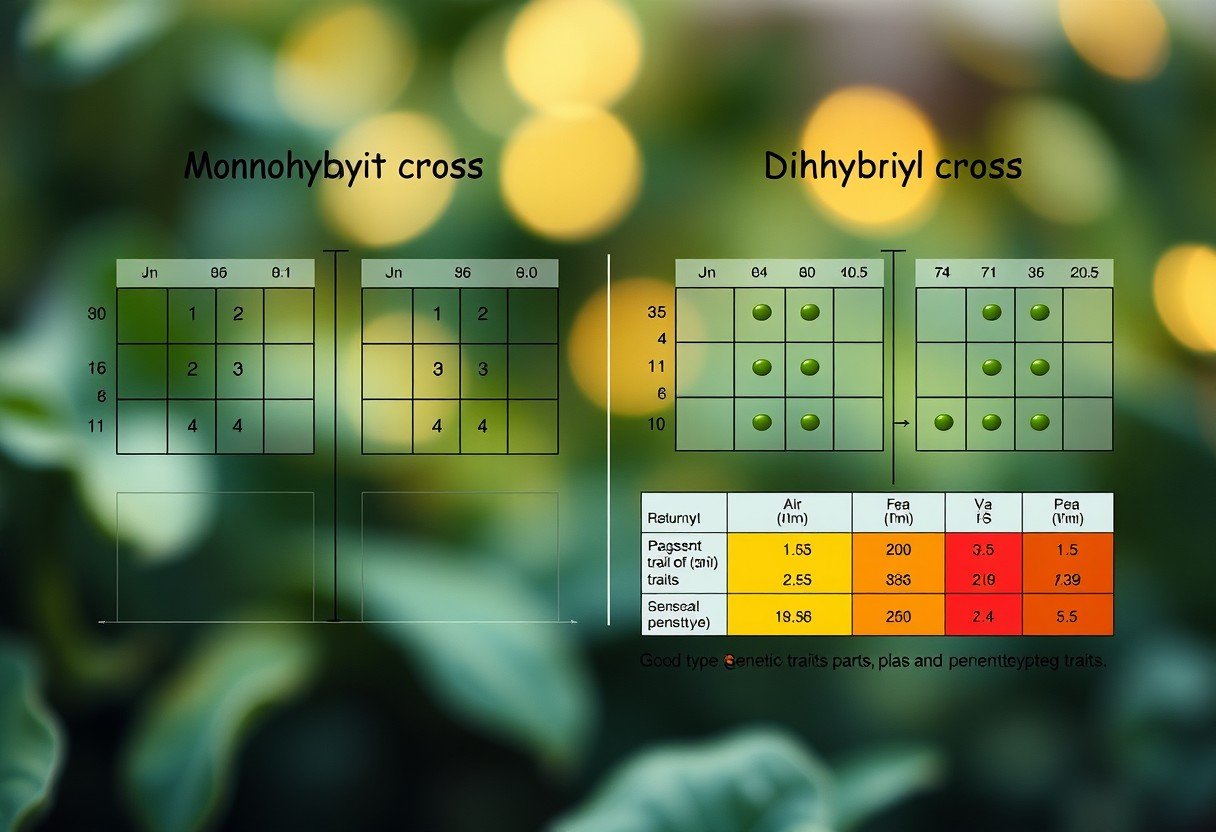Have you ever wondered how traits like eye color or height are passed from parents to children? The answers lie in genetics, and two of the most fundamental concepts are monohybrid and dihybrid crosses. Pioneered by Gregor Mendel in the 19th century, these experiments study how traits are inherited. A monohybrid cross looks at a single trait, while a dihybrid cross examines two at once. Understanding them is key to unlocking the secrets of heredity.
What is a Monohybrid Cross?
A monohybrid cross is a genetic mix between two individuals who have different variations for a single trait. Think of it as the simplest way to see genetics in action. This type of cross focuses on just one gene, such as the gene for flower color in pea plants.
The core idea behind a monohybrid cross is to observe how dominant and recessive alleles interact. When you cross a homozygous dominant parent (like a purple-flowered plant, PP) with a homozygous recessive parent (a white-flowered plant, pp), all the first-generation offspring will show the dominant trait.
This process perfectly illustrates Mendel’s Law of Segregation, which states that during the formation of reproductive cells (gametes), the two alleles for a trait separate from each other. This means each parent passes on only one of their two alleles to their offspring, allowing for predictable inheritance patterns.
Understanding the Dihybrid Cross
A dihybrid cross takes things a step further by tracking the inheritance of two different traits at the same time. For instance, a geneticist might want to study both seed color (yellow or green) and seed shape (round or wrinkled) in pea plants. This allows us to see how different genes interact with each other as they are passed down.
This type of cross is foundational for understanding Mendel’s Law of Independent Assortment. This law explains that the alleles for one trait segregate independently of the alleles for another trait. In other words, inheriting a specific seed color doesn’t affect the chances of inheriting a particular seed shape. This independence is what creates a wide variety of genetic combinations in offspring.
Key Differences Between Monohybrid and Dihybrid Crosses
The most obvious difference between these two genetic tools is the number of traits being analyzed. A monohybrid cross keeps it simple with one trait, while a dihybrid cross doubles the complexity by looking at two. This core distinction leads to very different outcomes and ratios.
The expected ratios of observable traits (phenotypes) are a classic giveaway. In the second generation (F2) of a monohybrid cross, you typically see a 3:1 ratio of dominant to recessive traits. However, a dihybrid cross produces a more complex 9:3:3:1 ratio, representing all possible combinations of the two traits.
| Feature | Monohybrid Cross | Dihybrid Cross |
|---|---|---|
| Number of Traits Studied | One | Two |
| Number of Genes Involved | One | Two |
| Typical F2 Phenotypic Ratio | 3:1 | 9:3:3:1 |
| Mendelian Law Illustrated | Law of Segregation | Law of Independent Assortment |
Practical Uses of Monohybrid Crosses
Monohybrid crosses are more than just a classroom concept; they have powerful real-world applications, especially in breeding. By focusing on a single desirable trait, scientists and farmers can make targeted improvements to plants and animals.
In agriculture, these crosses help create crops with specific advantages. For example, a breeder can focus solely on developing a strain of wheat that is resistant to a common disease. This targeted approach is efficient and yields predictable results.
Similarly, in animal genetics, monohybrid crosses are used to enhance livestock. Breeders can use them to:
- Improve milk production in dairy cows.
- Increase growth rates in cattle raised for meat.
- Select for specific coat colors or patterns in domestic animals.
By isolating and analyzing one trait at a time, breeders can effectively eliminate undesirable characteristics while promoting beneficial ones, leading to healthier and more productive animal populations.
Why Dihybrid Crosses Matter in the Real World
Dihybrid crosses are essential for tackling more complex genetic challenges, particularly in modern agriculture. They allow breeders to develop organisms that have multiple desirable traits at once, which is crucial for meeting global food demands.
A primary application is in agricultural improvement. Imagine developing a new variety of corn. Using dihybrid crosses, breeders can simultaneously select for both high yield and strong pest resistance. This creates a “super crop” that is not only productive but also resilient, reducing the need for chemical pesticides and increasing food security.
These crosses also provide vital insights into complex traits that are influenced by multiple genes. By observing how two different genes interact, researchers can begin to unravel the genetic basis of characteristics like disease susceptibility or drought tolerance. This knowledge is critical for advancements in medicine, conservation, and biotechnology.
Frequently Asked Questions
What is a monohybrid cross?
A monohybrid cross is a genetic experiment that studies the inheritance of a single characteristic. It involves breeding two individuals who have different versions (alleles) of one specific gene to observe the outcomes in their offspring.
What distinguishes a dihybrid cross from a monohybrid cross?
The main difference is the number of traits being studied. A monohybrid cross looks at one trait controlled by one gene, while a dihybrid cross examines the inheritance of two different traits controlled by two separate genes simultaneously.
Can you explain the significance of Mendel’s laws in these crosses?
Mendel’s Law of Segregation is demonstrated in monohybrid crosses, explaining how alleles for one trait separate into different gametes. The Law of Independent Assortment, key to dihybrid crosses, states that genes for different traits are inherited independently of each other.
What practical applications do these crosses have today?
They are fundamental in plant and animal breeding to improve crop yields, create disease-resistant varieties, and enhance livestock genetics. They are also used in genetic research to understand how specific genes influence traits.
How can you predict the results of a cross?
A Punnett square is a simple graphical tool used to predict the possible genotypes and phenotypes of offspring. For a monohybrid cross, a 2×2 square is used, while a dihybrid cross requires a larger 4×4 square to account for all allele combinations.









Leave a Comment